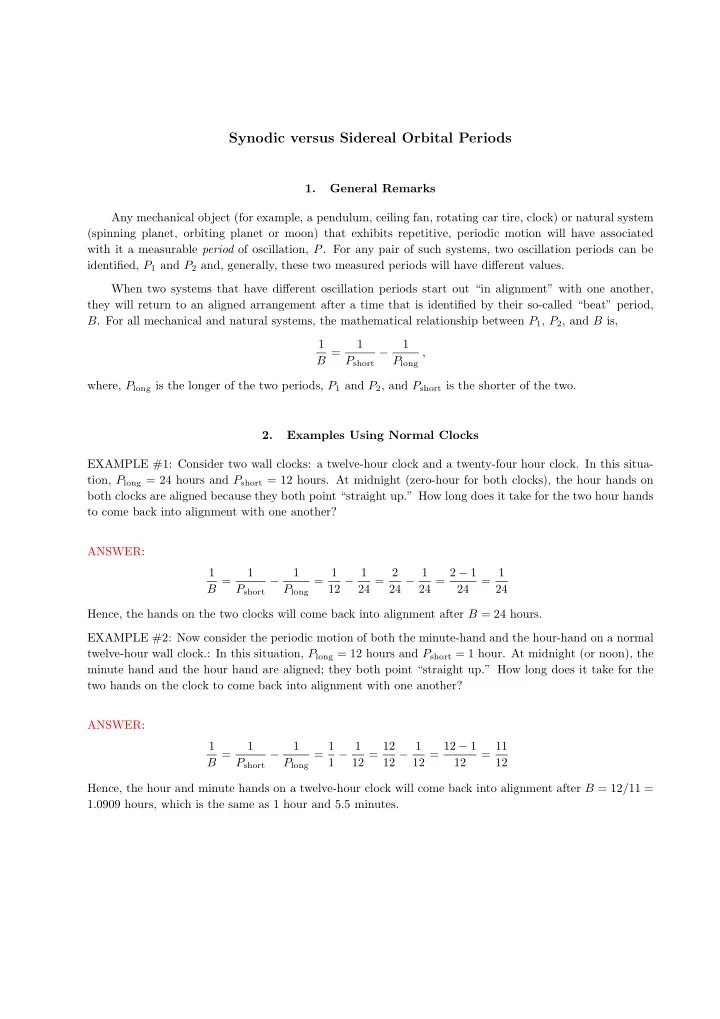

Synodic versus Sidereal Orbital Periods 1. General Remarks Any mechanical object (for example, a pendulum, ceiling fan, rotating car tire, clock) or natural system (spinning planet, orbiting planet or moon) that exhibits repetitive, periodic motion will have associated with it a measurable period of oscillation, P . For any pair of such systems, two oscillation periods can be identified, P 1 and P 2 and, generally, these two measured periods will have different values. When two systems that have different oscillation periods start out “in alignment” with one another, they will return to an aligned arrangement after a time that is identified by their so-called “beat” period, B . For all mechanical and natural systems, the mathematical relationship between P 1 , P 2 , and B is, 1 1 1 B = , − P short P long where, P long is the longer of the two periods, P 1 and P 2 , and P short is the shorter of the two. 2. Examples Using Normal Clocks EXAMPLE #1: Consider two wall clocks: a twelve-hour clock and a twenty-four hour clock. In this situa- tion, P long = 24 hours and P short = 12 hours. At midnight (zero-hour for both clocks), the hour hands on both clocks are aligned because they both point “straight up.” How long does it take for the two hour hands to come back into alignment with one another? ANSWER: 1 1 1 = 1 12 − 1 24 = 2 24 − 1 24 = 2 − 1 = 1 B = − P short P long 24 24 Hence, the hands on the two clocks will come back into alignment after B = 24 hours. EXAMPLE #2: Now consider the periodic motion of both the minute-hand and the hour-hand on a normal twelve-hour wall clock.: In this situation, P long = 12 hours and P short = 1 hour. At midnight (or noon), the minute hand and the hour hand are aligned; they both point “straight up.” How long does it take for the two hands on the clock to come back into alignment with one another? ANSWER: 1 1 1 = 1 1 − 1 12 = 12 12 − 1 12 = 12 − 1 = 11 B = − P short P long 12 12 Hence, the hour and minute hands on a twelve-hour clock will come back into alignment after B = 12 / 11 = 1 . 0909 hours, which is the same as 1 hour and 5.5 minutes.
– 2 – EXAMPLE #3: Consider the situation where one 12-hour clock keeps perfect time, and another gains five minutes every hour. If the clocks start out synchronized, how long will it take for the hour-hands on the two clocks to show exactly the same time again? ANSWER: Which of the following is correct? A . ] P short = 55 minutes B = 11 hours ⇒ B . ] P long = 65 minutes B = 13 hours ⇒ C . ] P short = 55 minutes B = 13 hours ⇒ D . ] P long = 55 minutes B = 11 hours ⇒ 3. Examples Using Planetary Orbits EXAMPLE #5: Consider two planets that orbit about the same star, one with an orbital period of P 1 = 1 year and the other with an orbital period of P 2 = 5 years. At some point the two planets and the central star are found to lie along a straight line, and the planet with the shorter orbital period lies between the other two objects on that line. How long does it take for the planets to return to precisely this same alignment? ANSWER: 1 1 1 = 1 1 − 1 5 = 5 5 − 1 5 = 5 − 1 = 4 B = − P short P long 5 5 Hence, the planets fall back into alignment with the central star every B = 5 / 4 years, that is, every 1.25 years. EXAMPLE #6: On one particular night, Copernicus notices that the planet Mars is rising on the eastern horizon just as the Sun is setting on the western horizon. This means that Mars, the Earth, and the Sun lie along a straight line with the Earth positioned between the other two objects. On many subsequent days/nights, Copernicus continues to watch the motion of Mars across the sky and finds that this same Mars-Earth-Sun alignment occurs 780 days later. Given this information, Copernicus was able to deduce the orbital period of Mars, P Mars . ANSWER: In this case, Copernicus knew that the orbital period of the Earth was P Earth = 1 year and the measured period (between planetary alignments) was the “beat period,” B = 780 days, that is, B = 2 . 14 Earth years. Hence, he could calculate P Mars from the equation, 1 1 − 1 B = 1 1 = 2 . 14 = 1 − 0 . 467 = 0 . 533 1 − P Mars P Earth Hence, P Mars = 1 / 0 . 533 Earth years, that is, P Mars = 1 . 9 years.
– 3 – EXAMPLE #7: For each of the measured “beat” (synodic) periods of the planets that are listed in the following table, calculate the planet’s corresponding orbital period. ANSWER: You fill out the table! Table 1. Planetary Orbital Periods Planet Synodic Period Orbital Period Mercury 116 days ? Venus 584 days ? Mars 780 days ? Jupiter 399 days ? Saturn 378 days ?
Recommend
More recommend